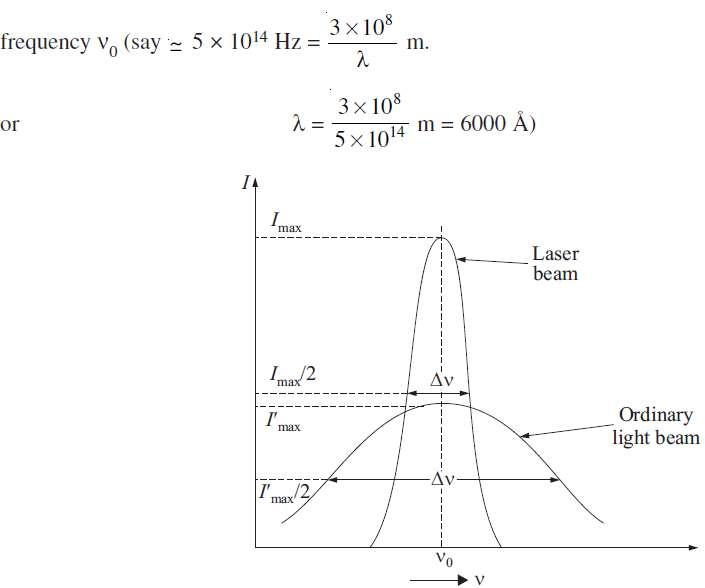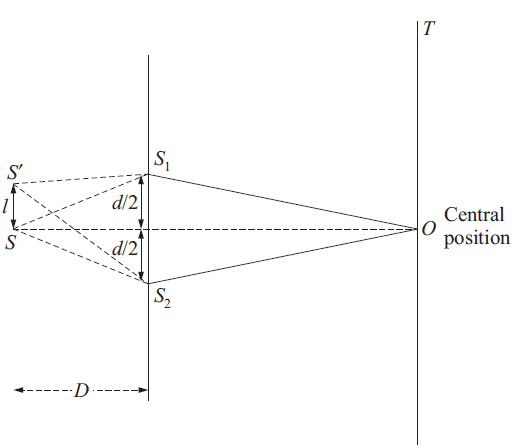Main Features Of Laser
Main Features of laser: The most striking features of a laser are the following:
(a) Directionality: A conventional source of light (like a sodium lamp or an incadescent bulb) emit radiations in all directions. An aperture is used in front of such a source to get a narrow beam of light, whereas laser emits radiations only in one direction. Thus laser has high degree of beam directionality. For a typical laser, the beam divergence is found to be less than one milliradian. It means that laser beam spreads less than one millimeter for every meter travelled by it. For example, the spread of laser beam sent from earth to moon (384400 km) is just few kilometers.
(b) Intensity: The light from a conventional source spreads out uniformly in all the directions. At distance of 30 cm from a 100 watt bulb, power entering* the eye is less than 1/1000 watt. On the other hand the laser gives out light into a narrow beam and its energy is concentrated in a small region. Therefore even a laser of 1 watt would appear thousand times more intense than 100 watt ordinary bulb.
(c) Monochromaticity: The light emitted by a laser is extraordinary monochromatic. Monochromaticity (single wavelength) of a laser light is much more than that of any conventional monochromatic source. Broadening of the emitted light from a source is the result of non-monochromaticity. An inspection of a line emitted by an ordinary monochromatic source reveals that it has a spread (or width) over a frequency range of thousands of mega Hertz (~ 1010 Hz) whereas the spread (or width) of laser light is almost negligible (~ 500 Hz). This is shown in Fig.1 for the monochromatic light of

fig..(1) Band widths for laser and ordinary light beam
The spread in laser beam is largely due to the presence of ‘spontaneous’ emission in addition to stimulated emission.
(d) Coherence: Coherence is a measure of the degree of phase correlation that exists in the radiation field of a light source at different locations and different times. Due to stimulated emission in laser the photons are emitted in the same phase and there is very high degree of coherence in laser as compared to the conventional coherent sources. The wave front of the light emitted by conventional monochromatic light source change from one point to the other and varies from instant to instant. Corresponding to these there are two concepts of coherence, namely spatial coherence (on lateral coherence) and temporal coherence (or longitudinal coherence).
(i) Spatial Coherence or Lateral Coherence: To understand spatial coherence consider two points P1 and P2 which, at time t = 0, lie on the same wave front of some given electromagnetic wave and let E1(t) and E2(t) be the corresponding electric fields at these points. According to definition the difference between the phases of the two fields at time t = 0 is zero. If this difference in phase remains zero at any time t > 0, we would say that there is perfect coherence between these two points i.e., we will say that the wave has perfect spatial coherence. Thus if the electric fields at any two different points on the e.m., wave front has constant phase difference over any time t, then perfect coherence is said to occur. The concept of spatial coherence can be understood by Young’s double slit experiment as shown in Fig. 2. Here S is a point source, S1 and S2 are equally spaced pinholes. Now on the screen T near the central position O one would get interference fringes of good contrast. Let us now consider another point source S′ placed near S and there is no phase relationship between the waves from S and S′. Now the interference pattern on the screen T will be due to super position of intensity coming from sources S and S′ through the pinholes S1 and S2. If S′ is moved slowly away from S, the contrast of fringes becomes poorer. For a particular distance SS′ such that S′S2 – S′S1 = λ 2 , the interference maximum produced by S falls on the interference minimum produced by S′ and vice versa. At this position of S′ the interference fringes due to S will just disappear and uniform illumination on the screen is observed. From the geometry of the Fig. 2.
 Fig. 2. Young’s double slit experiment to study the spatial coherence of a light source
Fig. 2. Young’s double slit experiment to study the spatial coherence of a light source